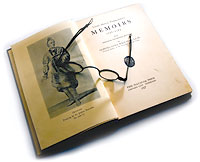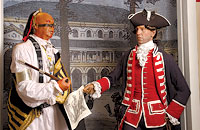
Nothing ’bout Britney in this page turner: a first-edition copy of Timberlake’s Memoirs.
|
A public announcement in the June 21, 1762 issue of The Gentlemen’s Magazine described new guests to England:
“Three Cherokee Indian Chiefs arrived in London from South Carolina. They are well made men, near six feet high, were dressed in their own country habit, with only a shirt, trowsers, and a mantle round them; their faces are painted of a copper colour, and their heads adorned with shells, feathers, ear-rings, and other trifling ornaments.” The writer added later that “cloaths have been given them in the English fashion.”
The “well made men” — who apparently, by their appearance alone, were straining English notions of propriety — were none other than the Cherokee commander-in-chief Ostenaco; another chief, Cunne Shote; and an aide named Woyi.

“Awe and veneration”?: Emissaries of Peace depicts Cherokee life from an English Colonial viewpoint, which was alternately violent, condescending and admiring.
|
The English were hungry for sensation, and during a month-and-a-half tour of the country, the three men made all the papers, were described in detail in ladies’ diaries and gentlemen’s memoirs, sat for countless portraits, and were even immortalized in a lithograph by William Hogarth. Their guide to Albion was Henry Timberlake, an English lieutenant who came, as part of the terms of a treaty, to live with the Cherokee earlier that same year.
Timberlake may not be a household name (except as regards a contemporary R&B singer of questionable talent and permanent five-o’clock shadow), but the young lieutenant’s diary from that period is today considered one of the most faithful and vivid descriptions of Cherokee life and culture, ranking alongside works by the Philadelphia botanist William Bartram and the 19th-century observations of James Mooney.
In its exhibit Emissaries of Peace, the Museum of the Cherokee Indian in Cherokee takes a page, and more, from Timberlake’s Memoirs.
Through its faithful attention to Timberlake’s accounts and reliance on artifacts, the display should disabuse any images of the Cherokee involving rubber-tipped spears and ceremonial headdresses. The idea for it came originally from Dr. Duane King, former director of the museum, says Ken Blankenship, the venue’s current director.
“About eight years ago we got a little more serious about it and started some planning,” says Blankenship. “At the time we were just designing it. We had no idea what it would cost.”
Fundraising followed for the exhibit, whose final tally was $750,000. An additional $300,000 from the National Endowment for the Humanities has allowed Emissaries to go on the road.
“We felt it was important to get the truth out to the people about this period of history,” says Blankenship. Emissaries heads next to the University of Tennessee. In spring 2007, the exhibit will carve out a spot at the National Museum of Natural History in Washington, D.C.
Emissaries is the museum’s most ambitious exhibit since it opened at its current location in 1976. More than 250 artifacts are on display, including the odd (a coil of brass used for plucking hair), the beautiful (wampum belts, earrings), the ornate (silver gorgets worn by British soldiers and Cherokee warriors alike) and the dual-purpose (a combination tomahawk-pipe.)
The floor plan is laid out chronologically, walking visitors through the series of historical events leading up to Timberlake’s sojourn with the Cherokee, his travels (long on both hardship and miles covered), his stay with the Indians, later travels to England, and summary details.
At the time of Timberlake’s visit, the Cherokee were one of the most culturally advanced tribes in North America, inspiring respect among some English and colonists.
But while choice aspects and figures from the culture were celebrated (a young Thomas Jefferson described his “awe and veneration” at Chief Ostenaco’s “sounding voice, distinct articulation and animated action”), indifference or violence were more often the English’s ready responses.
In fact, the years leading up to Timberlake’s stay with the Cherokee were epically bad for the tribe. Waves of disease had devastated the Cherokee, shaking the culture to the root. And in spite of their faithful aid to the British during the French and Indian war, bad things kept coming. In the spring of 1761, a British force of 2,600 led by Lt. Colonel James Grant burned 15 of the Cherokee’s middle towns, destroyed 1,500 acres of crops and drove, according to a contemporary observer, “five thousand Cherokees into the mountains to starve.”
Out of this mess, in 1762, came a spot of repose in Timberlake’s gentle observations of daily life and ceremony among the tribe. Archaeological digs in the 1960s and 1970s confirmed as fact many of his descriptions.
Timberlake put words to the sight of the Cherokee war dance, on less bellicose ceremonies, on agriculture, commerce and crafts. On the appearance of Cherokee men, Timberlake wrote: “Their countenance and actions exhibit [an] air of magnanimity, superiority and independence. Their complexion of a reddish brown or copper colour; their hair long, lank, coarse and black as a raven, and reflecting the like luster at different exposures to light.”
Cherokee women he described as “tall, slender, erect and of a delicate frame, their features formed with perfect symmetry, their countenance cheerful and friendly, and they move with a becoming grace and dignity.”
As fate would have it, the Englishman died in poverty just three years after his stay with the Cherokee, too soon to see his Memoirs in print. But the images they contain, of a complex culture accommodated to the fertile, green “wilds,” would help inspire a generation of Romantic poets, including Byron, Keats, Shelley and Coleridge. That, and a traveling exhibit to boot, is perhaps compensation enough — at least for Timberlake.
Emissaries of Peace is on display at the Museum of the Cherokee Indian (Hwy. 441 at Tsali Boulevard, in Cherokee) through Friday, Sept. 15. Call (828) 497-3481 or visit cherokeemuseum.org.



Before you comment
The comments section is here to provide a platform for civil dialogue on the issues we face together as a local community. Xpress is committed to offering this platform for all voices, but when the tone of the discussion gets nasty or strays off topic, we believe many people choose not to participate. Xpress editors are determined to moderate comments to ensure a constructive interchange is maintained. All comments judged not to be in keeping with the spirit of civil discourse will be removed and repeat violators will be banned. See here for our terms of service. Thank you for being part of this effort to promote respectful discussion.